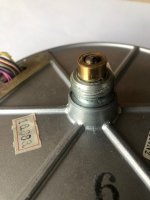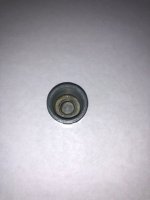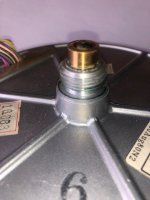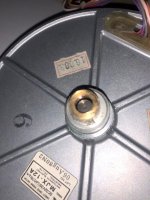I was pleased to see that claim about Mk1 vs Mk2, though I'm sure there will be others who vehemently dispute it. I have no stake in that debate. But at least it sounds as if the Mark I can be a worthy deck. I use an SP25 (yes, I have too many turntables), so I certainly appreciate the quartz control and the fast braking. But I can live without it. Some of my other turntables use AC motors, and none of them, AC or DC driven, are quartz-controlled or come to a stop as fast as the SP25.
This will be a bit of a project deck. I have yet to see what kind of condition it arrives in. It's in a not-so-beautiful wooden plinth, not from Technics I think, that looks about 1970s vintage and is a bit scuffed. That will do the job to start with, as it's built for and installed with two arms. I'm not a plinth-builder (yet) and don't have woodworking experience, so I will work out whether I want to do this myself or get a pro to do it. I haven't found who offers that service in this country and have no idea what would be a typical charge for the labour. That's a long way off though, because I'll need to be sure the deck is working properly first, and do any recapping that is needed.
This will be a bit of a project deck. I have yet to see what kind of condition it arrives in. It's in a not-so-beautiful wooden plinth, not from Technics I think, that looks about 1970s vintage and is a bit scuffed. That will do the job to start with, as it's built for and installed with two arms. I'm not a plinth-builder (yet) and don't have woodworking experience, so I will work out whether I want to do this myself or get a pro to do it. I haven't found who offers that service in this country and have no idea what would be a typical charge for the labour. That's a long way off though, because I'll need to be sure the deck is working properly first, and do any recapping that is needed.
I have always been curious about the SP15, which sits between the SP10 and SP25, but I have never come across one. The W&F specs seem on par with the SP10 and the single box format is appealing. They seem quite rare in my neck of the woods (Australia). There is also the SP12 which is cosmetically similar to the SP10 mkII but a single chassis. The SP12 speed specs seem a step behind the SP10 mkII so I am assuming the motor/controller is lesser quality.I use an SP25 (yes, I have too many turntables), so I certainly appreciate the quartz control and the fast braking. But I can live without it. Some of my other turntables use AC motors, and none of them, AC or DC driven, are quartz-controlled or come to a stop as fast as the SP25.
Oops. I meant SP20.There is also the SP12 which is cosmetically similar to the SP10 mkII but a single chassis.
I certainly have no complaints about the SP25. A great and very affordable deck. I wanted something without the (to me) DJ fripperies of the SL1200. The pitch slider is just too visually prominent. The SP15 seems to go for quite a lot more than the SP25. It is supposedly sonically superior, and has 78 rpm for those who need it, but with different electronics than the SP25, the 15 is the more likely model to need repair, from what I've read.
Part way there.
I prepared for a tussle getting the end cap off. I used Bons system to hold the motor and put heat to it with a propane torch. It unwound with virtually no force. Nothing like getting the locktite to release. Pictures attached.
I then tried to bonk the thrust ball out per 6L6's post #878. No go.
I used bamboo skewers taped together and even hitting them with a hammer it did not release.
Need suggestions. I don't want to force it. looking inside the cap it looks like both the sleve bearing and the ball bear on the cap. Do I need to take the bearing out?
Don
I prepared for a tussle getting the end cap off. I used Bons system to hold the motor and put heat to it with a propane torch. It unwound with virtually no force. Nothing like getting the locktite to release. Pictures attached.
I then tried to bonk the thrust ball out per 6L6's post #878. No go.
I used bamboo skewers taped together and even hitting them with a hammer it did not release.
Need suggestions. I don't want to force it. looking inside the cap it looks like both the sleve bearing and the ball bear on the cap. Do I need to take the bearing out?
Don
Attachments
No you don't need to take the bearing out. I use a bit of hardwood dowel down the top of the sleeve. I place the bottom of the sleeve on another bit of hardwood with a 7.5mm hole in it this prevents the sleeve from exiting the motor housing and the ball can fall on the bench through the hole.
Thanks, Warren.No you don't need to take the bearing out. I use a bit of hardwood dowel down the top of the sleeve. I place the bottom of the sleeve on another bit of hardwood with a 7.5mm hole in it this prevents the sleeve from exiting the motor housing and the ball can fall on the bench through the hole.
Next question is, what is the preferred loctite to refasten the cap with.
Thanks,
Don
I'm no expert and I am not saying I disagreee but the manufacturer did it for a reason and I try to follow their procedures.I don't block the cap with anything, it's impossible for it to loosen by itself, there's no oil to hermetically tighten to prevent it from escaping and there's no vibration to loosen the cap by itself.
Not that they advocate taking their motor out and installing it nude in a plinth.😕
Don
I always use Loctite 222 to ensure the bottom of the bearing housing is sealed and cannot leak oil especially as I always replace the steel ball with SI3N4 which is not as tight a fit in the sleeve. For me it's insurance as any SP10 I service I don't want it coming back to me that the bearing has leaked.
As an experimental approach and in keeping with the proposal to use a Plywood was interim Chassis Material or to Bed the Bearing Housing Base into a insitu' packing material.
It might be worth considering the use of Newplast Modellers Putty.
This has been measured for Damping and Frequency, and the difference in comparison to another material is shown in the list below. .
Frequency Damping
The Newplast may prove to be the ideal material to use in conjunction with Densified Wood as a Bedding Compound.
Additionally it can be used to improve a Plywood Chassis Damping.
From recollection there was once a discussion by the guy doing the measuring of materials foruse in HiFi, to apply the Newplast as Layers to build up on the Damping Factor 'from recollection ?' I believe approx' 40mm Thickness was required to get the better Damping Measurement from a 20mm Thick Wood Derivative Plinth Board, I can't recall the material that was used.
It is possible to acquire a Plywood or Bamboo that is compressed up to 850-1000Kg per m3 (approx' 40% increase over a typical board weight).
The Bamboo will be the Upper of the Weights with the Increased Compression.
This type of board compression used in conjunction with Newplast (added to a particular thickness), could prove to be a very good substitute to the Phenolic Resin Densified Wood at approx' 1400Kg per m3.
It definitely enables a experimentation with the Thickness of the entire structure, and this comes with the potential to be tuned to a individuals preferred sonic (or optimise the perception that the retrieval of the finest of details in a recording is being experienced ).
The Underline Text is a comment made last year by the guy doing and making available the measurements on Damping and Frequency properties of differing materials used for producing a Structure for HiFi.
This guy is a advocate of Densified Wood, stating a 10mm Thickness is the required thickness to get all the benefits.
It is stated that there is not benefit to be found in increasing the Thickness, but as known most are using a 25mm Thickness as standard.
"I have found a 'Plasticine' type product called Newplast to be effective in damping thin wooden plinths. Up to about 45mm is needed to be effective, however. Note, this is not cld! but extensional damping. HTH "
Also an individual in the UK used the Newplast in conjunction with 25mm P'holz, this was a P'holz/Newplast Structure that was approx' 70mm Depth.
After a period of Time and having access to a Naked P'holz Plinth for the same TT>Tonearm>Cart' decided on the Naked P'holz as their preferred.
It might be worth considering the use of Newplast Modellers Putty.
This has been measured for Damping and Frequency, and the difference in comparison to another material is shown in the list below. .
Frequency Damping
Plasticine' | 77 | 0.304 |
'Newplast' | 160 | 0.635 |
The Newplast may prove to be the ideal material to use in conjunction with Densified Wood as a Bedding Compound.
Additionally it can be used to improve a Plywood Chassis Damping.
From recollection there was once a discussion by the guy doing the measuring of materials foruse in HiFi, to apply the Newplast as Layers to build up on the Damping Factor 'from recollection ?' I believe approx' 40mm Thickness was required to get the better Damping Measurement from a 20mm Thick Wood Derivative Plinth Board, I can't recall the material that was used.
It is possible to acquire a Plywood or Bamboo that is compressed up to 850-1000Kg per m3 (approx' 40% increase over a typical board weight).
The Bamboo will be the Upper of the Weights with the Increased Compression.
This type of board compression used in conjunction with Newplast (added to a particular thickness), could prove to be a very good substitute to the Phenolic Resin Densified Wood at approx' 1400Kg per m3.
It definitely enables a experimentation with the Thickness of the entire structure, and this comes with the potential to be tuned to a individuals preferred sonic (or optimise the perception that the retrieval of the finest of details in a recording is being experienced ).
The Underline Text is a comment made last year by the guy doing and making available the measurements on Damping and Frequency properties of differing materials used for producing a Structure for HiFi.
This guy is a advocate of Densified Wood, stating a 10mm Thickness is the required thickness to get all the benefits.
It is stated that there is not benefit to be found in increasing the Thickness, but as known most are using a 25mm Thickness as standard.
"I have found a 'Plasticine' type product called Newplast to be effective in damping thin wooden plinths. Up to about 45mm is needed to be effective, however. Note, this is not cld! but extensional damping. HTH "
Also an individual in the UK used the Newplast in conjunction with 25mm P'holz, this was a P'holz/Newplast Structure that was approx' 70mm Depth.
After a period of Time and having access to a Naked P'holz Plinth for the same TT>Tonearm>Cart' decided on the Naked P'holz as their preferred.
Not that they advocate taking their motor out and installing it nude in a plinth.
LOL
this is an extremism that I don't like to get even with a gun to my head; even if I could do it even though I have six SP 10 II and several spare MJX-12A engines, I have no reason to make such a modification. IHMO
Just curious? What do you do with all those Mk2's and MJX-12A's?LOL
this is an extremism that I don't like to get even with a gun to my head; even if I could do it even though I have six SP 10 II and several spare MJX-12A engines, I have no reason to make such a modification. IHMO
- Home
- Source & Line
- Analogue Source
- The Incredible Technics SP-10 Thread




